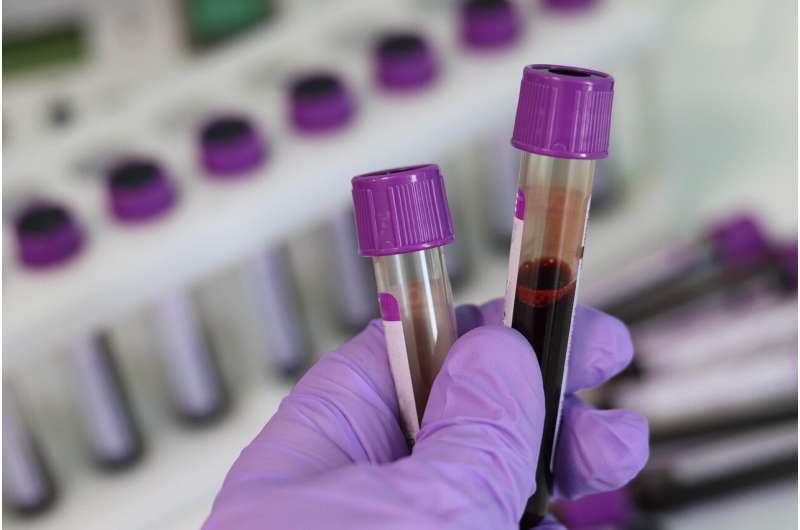This article has been reviewed according to Science X's editorial process and policies. Editors have highlighted the following attributes while ensuring the content's credibility:
fact-checked
peer-reviewed publication
trusted source
proofread
Injectable agents could improve liquid biopsy for cancer detection and monitoring

Scientists have developed two agents, made of therapeutic nanoparticles and antibodies, that could be given to patients shortly before a blood draw to allow physicians to better detect tumor DNA in blood using a technology called liquid biopsy.
Liquid biopsies promise to transform how cancers are diagnosed, monitored, and treated by detecting DNA that tumors shed into the blood. But the body's immune system presents a significant challenge. Immune cells in the liver and DNA-degrading enzymes in blood remove circulating tumor DNA from the bloodstream within minutes, making this DNA difficult to capture and detect in a blood test.
To overcome this, a team from the Broad Institute of MIT and Harvard and Massachusetts Institute of Technology (MIT) have developed two injectable "priming agents" that briefly slow down the clearance of circulating tumor DNA from the body, allowing levels of this DNA to temporarily increase in blood and be collected for testing.
The team says that these priming agents could improve the performance of liquid biopsies for cancer and potentially other diseases—akin to how contrast agents are given to patients to enhance medical imaging scans. Their findings are published in Science.
Viktor Adalsteinsson, director of the Gerstner Center for Cancer Diagnostics at Broad, Sangeeta Bhatia, an institute member at Broad, a professor at MIT and director of the Marble Center for Cancer Nanomedicine at MIT's Koch Institute, and J. Christopher Love, an associate member at Broad and a professor at MIT's Koch Institute, are co-senior authors of the study.
"Liquid biopsy stands to fundamentally change how cancer is diagnosed and treated but requires higher sensitivity," said Adalsteinsson. "To improve sensitivity, we sought to address for the first time the biology of circulating tumor DNA clearance, recognizing this is a fundamental hurdle upstream of most liquid biopsy tests which, if solved, could broadly benefit patients."
One of the priming agents consists of nanoparticles, which, like circulating tumor DNA, are consumed by immune cells in the liver. "We thought we could design a safe dummy nanoparticle to distract those immune cells and leave the circulating tumor DNA alone so that it could be at a higher concentration in blood samples," Bhatia said.
The other agent comprises engineered antibodies that bind to tumor DNA, protecting them from destruction by circulating enzymes. Both strategies—therapeutic nanoparticles and antibodies—are already well-established forms of medicine for use in humans.
"Existing liquid biopsy technologies are limited by the amount of tumor DNA you have in the tube of blood," Love said. "So we started to think about how we might inject something beforehand to help boost or enhance that signal."
Carmen Martin-Alonso, a graduate student in Bhatia's lab, spearheaded the design of the nanoparticles. Shervin Tabrizi, a postdoctoral associate in Love's lab and the Gerstner Center at the Broad and a radiation oncologist at Massachusetts General Hospital, took the lead on engineering the antibodies. And Kan Xiong, a research scientist at the Gerstner Center at the Broad, led an effort to optimize the analysis of single droplets of mouse blood for circulating tumor DNA.
In mouse studies, the team showed that administering these priming agents one to two hours before drawing a blood sample each increased the amount of circulating tumor DNA in a blood sample by more than 10-fold. This improved the sensitivity of detecting cancer by liquid biopsy in mice with low tumor burden from below 10% to more than 75%. Circulating tumor DNA levels in the animals returned to baseline within a day.
"The ability to get peak activity of these agents within a couple of hours, followed by their rapid clearance, means that someone could go to their doctor's office, receive an agent like this, and then give their blood for the test itself, all within one visit," Love said. "This feature bodes well for the potential to translate this concept into clinical use."
The team says their priming agents represent new platform technologies that could in principle enhance liquid biopsies not only for cancer but also for neurodegenerative diseases, metabolic disorders, deep-seeded infectious diseases, and prenatal genetic testing, as well as for the detection of other scarce analytes of clinical significance.
"Boosting circulating tumor DNA in blood is just the tip of the iceberg," Adalsteinsson said. "Priming is a new frontier we're excited to further develop in cancer diagnostics and beyond."
More information: Carmen Martin-Alonso et al, Priming agents transiently reduce the clearance of cell-free DNA to improve liquid biopsies, Science (2024). DOI: 10.1126/science.adf2341. www.science.org/doi/10.1126/science.adf2341
Journal information: Science
Provided by Broad Institute of MIT and Harvard





















